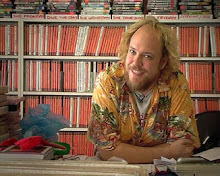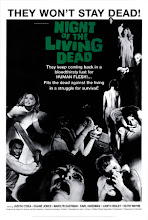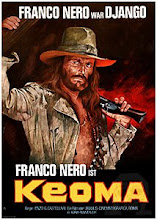
Santo In The Treasure Of Dracula
aka Santo En El Tesoro De Drácula
Director René Cardona Writer Alfredo Salazar
Cast Santo (Himself), Aldo Monti (Count Drácula), Noelia Noel (Luisa), Roberto G. Rivera (Dr. Kur) Tonight on Schlock Treatment we transplant the very European idea of vampires to
Tonight on Schlock Treatment we transplant the very European idea of vampires to
Our first film tonight features the Man in the Silver Mask, El Santo, in one of his numerous encounters with the fanged ones. Santo In The Treasure Of Dracula from 1968 would appear to be one of the final Santo films in b&w before the change to garish colour, but it was originally a colour film, and – horrors of horrors – a nudie. But more about that later...
 Loyal Schlock Treatment viewers and Mexican wrestling addicts will know that Santo is a man of many talents – the Macguiver of Luchadores, no less – but here we discover he is a quantum physicist, unveiling his new time machine for a gaggle of scientists at the home of Dr Sepulveda. Fans of the Time Tunnel series will recognize the capabilities of the huge spiral disc, but not the scientists, and it takes Sepulveda’s daughter Luisa to volunteer her services for
Loyal Schlock Treatment viewers and Mexican wrestling addicts will know that Santo is a man of many talents – the Macguiver of Luchadores, no less – but here we discover he is a quantum physicist, unveiling his new time machine for a gaggle of scientists at the home of Dr Sepulveda. Fans of the Time Tunnel series will recognize the capabilities of the huge spiral disc, but not the scientists, and it takes Sepulveda’s daughter Luisa to volunteer her services for
 And before you can say “What The Bleep Does Santo Know”, she goes spinning back – literally - into her previous life, that of a pale, aenemic, would-be vampire’s bride. Her father Dr Soler calls in renowned vampire hunter Professor Van Roth, who discovers Luisa’s gentleman caller Count Alucard has a cavern full of fanged love-slaves, turns into a rubber bat at will, and whose name when held up to a mirror spells “Dracula”! Santo, of course, has already deduced this, as he’s been watching the whole 19th Century adventure on close circuit TV. Alucard is staked, the vampiric Luisa returns kicking and spinning to present day
And before you can say “What The Bleep Does Santo Know”, she goes spinning back – literally - into her previous life, that of a pale, aenemic, would-be vampire’s bride. Her father Dr Soler calls in renowned vampire hunter Professor Van Roth, who discovers Luisa’s gentleman caller Count Alucard has a cavern full of fanged love-slaves, turns into a rubber bat at will, and whose name when held up to a mirror spells “Dracula”! Santo, of course, has already deduced this, as he’s been watching the whole 19th Century adventure on close circuit TV. Alucard is staked, the vampiric Luisa returns kicking and spinning to present day
 Except for the small question of Alucard’s treasure revealed on Santo’s TV. And so begins Part 2: a completely different monster featuring a villainous Black Hood and his wrestling son Atlas fighting Santo for the secret of Dracula’s treasure. It’s an Indiana Jones adventure and super villain caper with, once he’s unstaked, the greatest super villain of all. Let’s not forget the homage to Universal horrors that throws in every possible vampire film cliché, and even makes up a few (who knew vampires were repelled by mistletoe?), AND the fact the earlier part of the film (minus the saintly Santo, naturally) was padded out with nude scenes and released as El Vampiro y El Sexo! This version, sadly, only exists as a series of mildly pornographic postcards, begging the critical comment “Aye aye aye!”
Except for the small question of Alucard’s treasure revealed on Santo’s TV. And so begins Part 2: a completely different monster featuring a villainous Black Hood and his wrestling son Atlas fighting Santo for the secret of Dracula’s treasure. It’s an Indiana Jones adventure and super villain caper with, once he’s unstaked, the greatest super villain of all. Let’s not forget the homage to Universal horrors that throws in every possible vampire film cliché, and even makes up a few (who knew vampires were repelled by mistletoe?), AND the fact the earlier part of the film (minus the saintly Santo, naturally) was padded out with nude scenes and released as El Vampiro y El Sexo! This version, sadly, only exists as a series of mildly pornographic postcards, begging the critical comment “Aye aye aye!”
 As Santo In The Treasure Of Dracula, it’s more of a schizophrenic beast than most wrestling genre hybrids, but no less entertaining. Aldo Monti as Dracula is a suitably Hispanic substitute for Bela Lugosi, the vampire cavern is eye-popping even in its non-porn version, and the film introduces an interesting new dimension to Santo’s usually one-dimensional character. If his films are genetically pre-programmed to feature a mad scientist, then HE’s become the mad scientist, attempting to answer the big unknowable questions of the universe – but at what cost? All these questions – and more – will be answered as we unfold a two-dimensional Santo fighting an oddball assortment of cardboard cutouts in Santo In The Treasure Of Dracula.
As Santo In The Treasure Of Dracula, it’s more of a schizophrenic beast than most wrestling genre hybrids, but no less entertaining. Aldo Monti as Dracula is a suitably Hispanic substitute for Bela Lugosi, the vampire cavern is eye-popping even in its non-porn version, and the film introduces an interesting new dimension to Santo’s usually one-dimensional character. If his films are genetically pre-programmed to feature a mad scientist, then HE’s become the mad scientist, attempting to answer the big unknowable questions of the universe – but at what cost? All these questions – and more – will be answered as we unfold a two-dimensional Santo fighting an oddball assortment of cardboard cutouts in Santo In The Treasure Of Dracula.
 The Vampire
The Vampireaka El Vampiro
Director Fernando Méndez Writer Ramón Obón Producer Abel Salazar
Cast Abel Salazar (Dr. Enrique), Ariadna Welter (Marta Gonzalez), Carmen Montejo (Eloisa), Germán Robles (Count Karol de Lavud/Duval)
 Mexican cinema is still unknown outside its borders other than a few handfuls of movies dubbed into English. For a relatively poor country it had a remarkably prolific (not to mention proficient) film industry, turning out over 100 films a year during its peak years of the Fifties and Sixties. Masked wrestling genre films were just the tip of the filmic iceberg: from a cinema-obsessed culture sprang its own uniquely Mexican variations on gangster films, westerns, melodramas, science fiction, and of course, old-fashioned spook shows. Just as Hammer studios in
Mexican cinema is still unknown outside its borders other than a few handfuls of movies dubbed into English. For a relatively poor country it had a remarkably prolific (not to mention proficient) film industry, turning out over 100 films a year during its peak years of the Fifties and Sixties. Masked wrestling genre films were just the tip of the filmic iceberg: from a cinema-obsessed culture sprang its own uniquely Mexican variations on gangster films, westerns, melodramas, science fiction, and of course, old-fashioned spook shows. Just as Hammer studios in
 Sierra Negra, in the remote hills of
Sierra Negra, in the remote hills of
 The Sycamore’s hacienda is in an advanced state of decay, as is its previous owner: the Hungarian Count Lavud, staked through the heart and now lying in a sealed crypt in the basement. Enter Count “Duval”, asking to buy the estate. His credentials: a creepy hold over Eloise, a roving eye for Martha, a crate full of Hungarian dirt, presumably for a dead relative (hmm…), and his own coffin he returns to before daybreak. And so begins El Vampiro’s labyrinth of secrets and secret chambers, filmed to make the most of its mainly studio-bound sets, with wide angle lenses capturing their mouldering, mist-shrouded splendour.
The Sycamore’s hacienda is in an advanced state of decay, as is its previous owner: the Hungarian Count Lavud, staked through the heart and now lying in a sealed crypt in the basement. Enter Count “Duval”, asking to buy the estate. His credentials: a creepy hold over Eloise, a roving eye for Martha, a crate full of Hungarian dirt, presumably for a dead relative (hmm…), and his own coffin he returns to before daybreak. And so begins El Vampiro’s labyrinth of secrets and secret chambers, filmed to make the most of its mainly studio-bound sets, with wide angle lenses capturing their mouldering, mist-shrouded splendour.
 Spanish-born German Robles - tall, gaunt, distinguished and with a distinctly patrician nose – was a poet and stage actor before he caught the eye of actor/producer Abel Salazar. Casting him as “Duval”/Lavud in El Vampiro and the 1958 sequel The Vampire’s Coffin sealed Robles’ fate, forever typecasting him as a bloodless artistocrat, vampire or otherwise. Robles would later play the Nostradamus The Monster Crusher in a series of memorable horror films in the early Sixties, but he resisted the urge to capitalize on his El Vampiro fame, preferring more oddball character roles, which he plays on Mexican TV to this day.
Spanish-born German Robles - tall, gaunt, distinguished and with a distinctly patrician nose – was a poet and stage actor before he caught the eye of actor/producer Abel Salazar. Casting him as “Duval”/Lavud in El Vampiro and the 1958 sequel The Vampire’s Coffin sealed Robles’ fate, forever typecasting him as a bloodless artistocrat, vampire or otherwise. Robles would later play the Nostradamus The Monster Crusher in a series of memorable horror films in the early Sixties, but he resisted the urge to capitalize on his El Vampiro fame, preferring more oddball character roles, which he plays on Mexican TV to this day.
 Rather than a direct steal of its European templates, The Vampire and its 1958 sequel The Vampire’s Coffin more than stand on their own merits. The parallels with Hammer’s first Dracula film from the next year are glaring, particularly in the fiery finale with Abel Salazar doubling Peter Cushing’s Van Helsing and Robles as a very worthy counterpart of Christopher Lee’s Dracula. But comparisons are unfair, considering the much smaller budget and market The Vampire was aiming for; its English-dubbed version appeared several years later as part of a package of wrestling and horror films purchased by K. Gordon Murray, bringing The Vampire to a much wider international audience than Salazar ever intended. If anything, the film overreaches its limitations and becomes something greater than the sum of its parts: a minor masterpiece from a much-neglected and almost forgotten film culture. We’re proud to present the 1957 El Vampiro, or The Vampire.
Rather than a direct steal of its European templates, The Vampire and its 1958 sequel The Vampire’s Coffin more than stand on their own merits. The parallels with Hammer’s first Dracula film from the next year are glaring, particularly in the fiery finale with Abel Salazar doubling Peter Cushing’s Van Helsing and Robles as a very worthy counterpart of Christopher Lee’s Dracula. But comparisons are unfair, considering the much smaller budget and market The Vampire was aiming for; its English-dubbed version appeared several years later as part of a package of wrestling and horror films purchased by K. Gordon Murray, bringing The Vampire to a much wider international audience than Salazar ever intended. If anything, the film overreaches its limitations and becomes something greater than the sum of its parts: a minor masterpiece from a much-neglected and almost forgotten film culture. We’re proud to present the 1957 El Vampiro, or The Vampire.























































































No comments:
Post a Comment